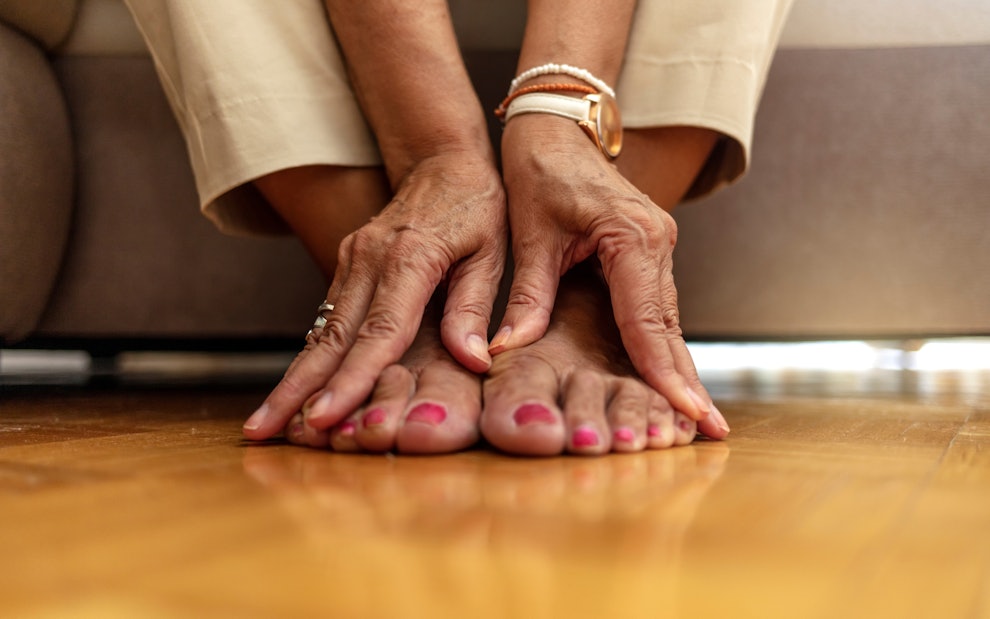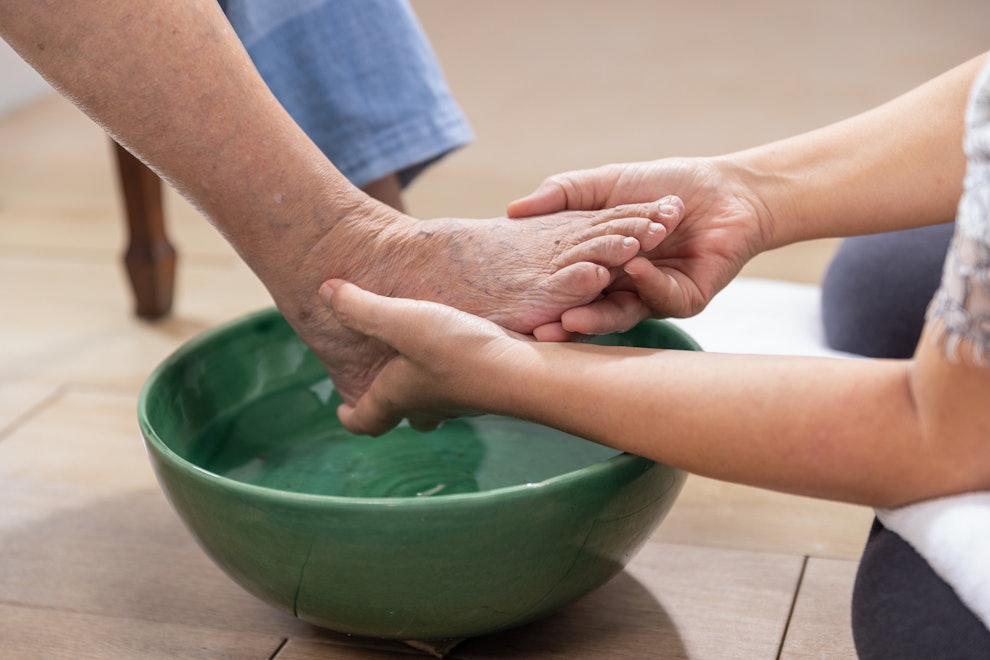Article at a glance
Foot pain is common and has many causes — such as injuries, diabetes, deformities, and strains.
Treatment for foot pain varies based on the cause, but there are simple steps you can take to help heal your feet.
If you experience foot pain that doesn’t go away, extreme swelling, or signs of infection, it’s time to get professional help from a doctor.
You can look after your feet with a simple routine that keeps them clean, dry, and well-supported.
Medicare has podiatry coverage for a range of foot pain issues, and Oak Street Health has podiatrists available to help your feet heal.

Foot pain can cause discomfort in many people. In fact, foot pain is so common that 87% of people experience it at some point in their lives. Foot pain can cause complications — including mild discomfort, preventing a person from walking, and serious infections. Diagnosing the right type of foot pain is the first step in treating the issue. Once you know the cause, there are many simple treatments to help ease or prevent foot pain. From basic foot care instructions to visiting with a podiatrist, Oak Street Health is here to help every step of the way.
Symptoms of Foot Pain
Symptoms of foot pain can include aches, pain, or discomfort in any part of your foot. You might feel any of these in your toe, heel, ball, edge, or arch of your foot. Other signs might include swelling, redness, roughness, lumps, or bumps. A podiatrist — foot doctor — is specially trained to identify and treat symptoms of foot pain.
Common Types of Foot Pain

Because there are many parts to a foot, there are many types of foot pain. There are 26 bones and 33 joints in each foot, which means there are a lot of working parts from which your foot pain can come. Here are some common types of foot pain:
Corns and Calluses
These are thick layers of tough skin that build up in an area of your foot. This happens when there is pressure or irritation. Poor-fitting shoes are often the cause of corns or calluses.
Poor Nail Care
Poorly clipped or long nails can lead to issues — such as ingrown toenails — that cause foot pain. If you cut your nail too short, this can expose some of the sensitive nerves in your nail bed. If left too long, nails can grow into your skin or press against the inside of your shoe.
Heel Spurs
These are bone growths on the underside of the heel that cause pain. Wearing shoes that don’t fit well, being overweight, and experiencing stretched tendons can cause heel spurs.
Bunions
Bone or tissue that collects in a joint and creates a raised bump causes bunions. You’ll find these at the base of your little or big toe. Repeated stress causes these, like when wearing tight-fitting shoes.
Morton Neuroma
When excess tissues build up between the bones of your foot, this causes Morton neuroma. This results in tenderness, swelling, and pain.
Diabetes
Diabetes can damage the nerves in your feet and cause burning, tingling, and pain. This condition also slows healing, which can make it more difficult for other foot issues to heal.
Treatments for Foot Pain

Foot Bath
Soaking your feet in warm water and Epsom salts for minutes will help reduce swelling and muscle pain. Be sure to apply moisturizer afterward, as Epsom salts dry out your skin.
Proper Fitting Shoes
Shoes that don’t fit well, because they’re too big or too small, will hurt your feet. Your feet will rub against the inside of the shoe, or the shoe won’t support your foot properly. An improper shoe fit can cause many of the issues listed above.
Arch Supports
Getting inserts for your shoes will help support your arches and decrease your foot pain. If the bottom of your feet hurt or feel strained, invest in the right size arch supports for relief.
Stretches and Strengthening
Basic foot stretches will help to strengthen your feet and relieve some of the tension, strain, and pain. Both bottom-of-the-foot and top-of-the-foot stretches are useful.
Pain Relievers
Over-the-counter pain relievers such as ibuprofen (Advil) or acetaminophen (Tylenol) can help relieve foot pain. Always follow the instructions on the bottle and talk to your doctor if they don’t help provide relief.
Foot Care Basics
Hygiene
Keeping your feet clean is important. When you bathe or shower, wash your feet with soap and water. This helps remove dirt and bacteria that can irritate your skin or cause infections. Be sure to dry them well afterward.
Inspections
Regular inspections can help you pinpoint the cause of your foot pain. Examine your feet for the following:
Swelling
Redness
Roughness
Sensitivity
Lumps or bumps
Clip Your Nails
The best time to trim your nails is after a shower or bath. This leaves them clean and softer which makes them easier to cut. You can follow these easy steps to trim your nails.
Ask a family member or friend to help if you can’t comfortably reach your nails
Take off any nail polish with nail polish remover
Cut your nails straight across the top
Let your feet dry
Gently file rough or sharp edges
Moisturize
Keep your feet moisturized to avoid cracks or roughness on your skin. Moisturize regularly, such as after you bathe or shower.
Keep Your Feet Dry
After you shower, swim, or get your feet wet, dry them gently with a towel. Keep them exposed to air until they dry thoroughly.
Rotate Socks and Shoes
Changing your socks and shoes regularly is important for good hygiene. Change your socks every day to keep your feet clean. Swap your shoes often so that they can air out and stay fresh. Doing so will help prevent the buildup of dampness and bacteria.
When to Go to the Doctor

It can be difficult to know when to get professional help, but if you experience the following, it’s time to go to the doctor.
Pain that persists for several weeks
Pain that prevents you from performing everyday activities
Swelling that does not improve after 2–5 days of treatment
Severe swelling
Tingling, numbness, or burning on the bottom of your foot
Open or oozing wound
What Medicare Covers
Does Medicare cover podiatry? Yes, Medicare Part B covers a range of different foot issues and treatments. These include foot exams and treatments for medically necessary treatment for foot injuries or diseases like bunions, heel spurs, and hammer toe. They also cover diabetes-related nerve damage in the feet. If you’re asking yourself, “Where are foot doctors near me that accept medicare?” you can find a podiatrist at a convenient location with Oak Street Health.
You don’t need to live with foot pain. It’s important to learn the common types and causes of foot pain. While many types of foot pain have simple solutions, other causes can be serious situations. Take the time to care for your feet with good hygiene and comfortable shoes. Pay attention to how your feet feel and if you see any unusual bumps, swelling, or redness. When basic foot care isn’t taking care of the pain, it might be time to visit a podiatrist. And, since some Medicare plans cover podiatry, you can get the help you need without worrying about the cost.
Sources
https://www.healthinaging.org/a‑z-topic/foot-problems/basic-facts
https://www.hopkinsmedicine.org/health/conditions-and-diseases/foot-pain-and-problems
https://lluh.org/services/neuropathic-therapy-center/blog/7‑warning-signs-diabetic-nerve-pain
https://www.osfhealthcare.org/blog/how-to-prevent-aching-feet/
https://www.health.harvard.edu/staying-healthy/exercises-and-stretches-for-foot-health
https://www.mayoclinic.org/symptoms/foot-pain/basics/when-to-see-doctor/sym-20050792
Become a patient
Experience the Oak Street Health difference, and see what it’s like to be treated by a care team who are experts at caring for older adults.



